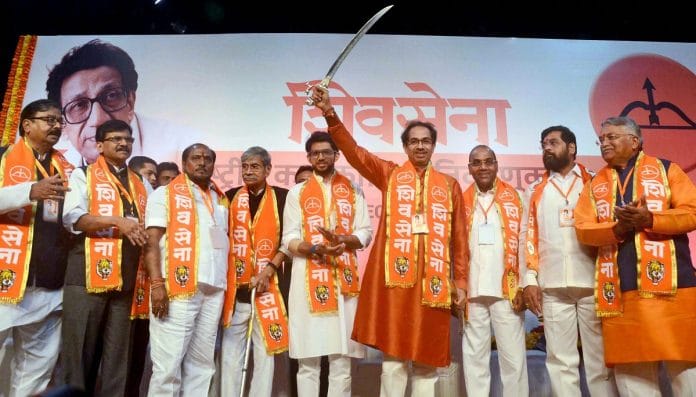The party, which won just 4 of the region’s 62 seats last election, is beefing up its organisational structure to combat ally BJP that hold 44 seats there.
Mumbai: Set to go it alone in next year’s assembly elections, the Shiv Sena has begun beefing up its organisational strength in Vidarbha, the party’s weakest link in Maharashtra and one that happens to be the stronghold of ally, the Bharatiya Janata Party (BJP).
For the past four months, the Sena has been concentrating on filling party posts in the region across all levels. It has also appointed some of its trusted leaders, close to the party headquarters in Mumbai, to tour the Vidarbha districts every fortnight and submit reports on the progress of the preparations.
With this, the party, which has just four legislators across the 62 assembly constituencies in Vidarbha, hopes to increase its number to double digits in the 2019 Maharashtra assembly polls. Overall, the party has 63 legislators in the state.
“In our alliance of almost three decades, we always conceded 80-85 per cent of the seats in Vidarbha to the BJP. As a result, we did not focus on growing in the region at all. But with the work that we have been putting in now, we feel much stronger in the region than what we were during the 2014 assembly polls,” said Arvind Nerkar, a Mumbai-based Shiv Sena leader and the party’s samanvayak (co-ordinator) for the Vidarbha region, said.
Nerkar is one of the four co-ordinators that the Shiv Sena appointed in January, assigning each of them one region of the state to look after.
The Shiv Sena and BJP were allies until the 2014 assembly election when the parties splintered due to disagreements over seat-sharing. The Sena has supported the BJP-led government in a post-poll alliance, but now the party has resolved to go it alone in 2019 again, despite attempts by the BJP to get it to contest together.
Preparations in Vidarbha
Anandrao Adsul, the Shiv Sena MP from Vidarbha’s Amravati district, said the party initially focused on building its cadre from booth-level workers to district functionaries.
“The district chief was given the responsibility to ensure that there are functional taluka pramukhs (chiefs) under him. The taluka pramukhs had to ensure that all their deputy positions are occupied,” said Adsul. “Beyond that, the party built up its cadre from the city chief to shakha pramukhs to booth pramukhs. Most of this work is now done and our manpower is being put in place.”
The Shiv Sena is known for its shakha system — administrative branches that it sets up at the village level and at the councillor ward levels in cities. The party builds a volunteer base in every such shakha. These volunteers attend to people’s complaints such as clogged drains, inadequate water, lack of toilets and so on, and build goodwill for the party at the grassroots level during the non-election season. The same volunteers turn into the party’s foot soldiers during elections, conducting door-to-door campaigning and preparing voter lists.
“We are trying to see to it that every booth has at least four people. Last month, Shiv Sena chief Uddhav Thackeray visited all the districts of Vidarbha and gave precise instructions to the Sena cadre here. It was then that everyone really felt that work has started in full earnest,” Adsul said.
“To ensure that the leadership and cadre are in place, from the district chief to the booth chief, sampark pramukhs have been asked to visit the districts they are responsible for once every 15 days. On their return, they submit reports on the work happening at the ground level, including names of Shiv Sena workers they met right to the booth level, to the party leadership in Mumbai,” said a senior Shiv Sena leader who did not wish to be named.
The sampark pramukhs (communication chiefs) are mostly trusted old-timers who have been Sena workers, elected representatives or office bearers for long.
Leaders in Mumbai make random checks by calling the booths, which the sampark pramukhs claim to have visited, and take feedback.
There is one Shiv Sena Whatsapp group for every assembly constituency in the region where the district chief takes stock of preparatory activities. There are social media groups for every district too, where Sena functionaries in charge supervise activities, and all this is reported to the party’s samanvayak (co-ordinator) for Vidarbha who relays it to the party chief.
A negligible presence
The Shiv Sena has traditionally been strong in urban centres such as Mumbai, Thane, Aurangabad and Nashik. It has a sizeable presence in the Konkan region and in north Maharashtra as well. However, the party has always had a tepid presence in Vidarbha, which accounts for more than a fifth of the total 288 assembly seats in Maharashtra.
Currently, the party has four MLAs from Vidarbha as against the 44 that the BJP has from among the region’s 62 constituencies. Besides the BJP, the Congress too once had a stranglehold on Vidarbha. While the Shiv Sena’s presence in the region has only dwindled over the years, the BJP’s has exponentially increased.
In 2004, the Shiv Sena won nine assembly seats in the region, reducing its tally to eight in 2009 and four in 2014. The BJP on the other hand, held 21 seats after the 2004 assembly election and 19 after 2009. However, it crushed the Congress in the 2014 assembly elections, increasing its tally to 44 and cutting Congress’ presence to 10 seats from the 24 earlier.







It is still in the best interests of both partners to fight jointly. If the calculation is to maximise their political space by contesting separately and then come together after the election, as happened in October 2014,the Congress and the NCP, along with a few small formations like the PWP might get a simple majority. Neither the state government nor the BMC is sparkling. There could also be some national fatigue to deal with.